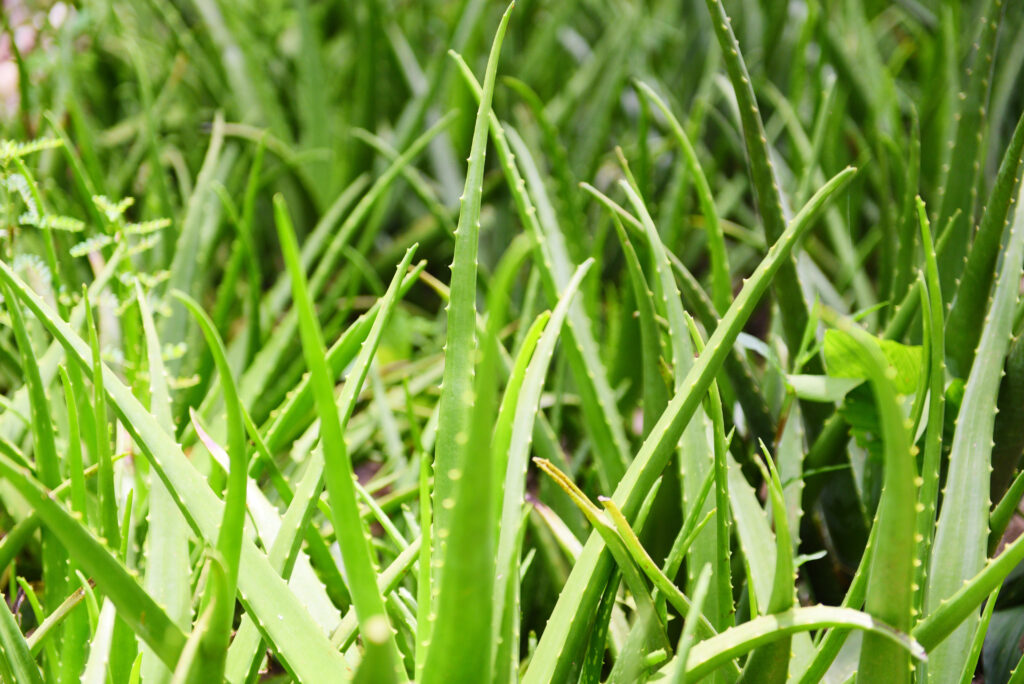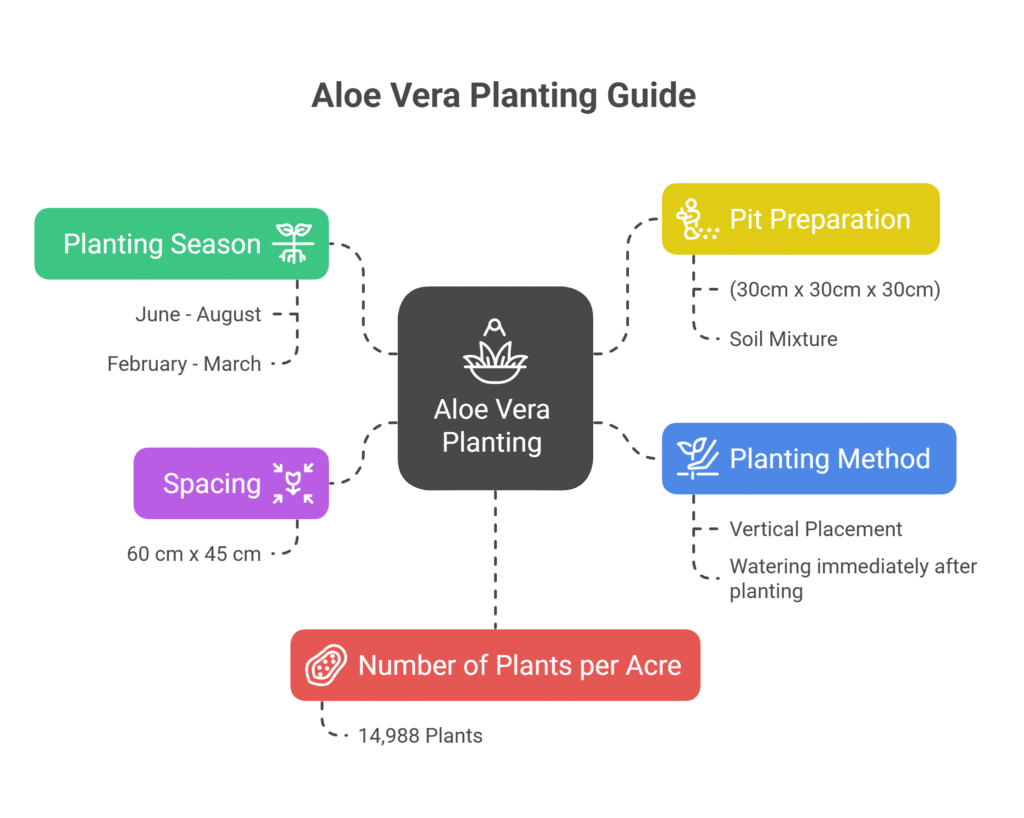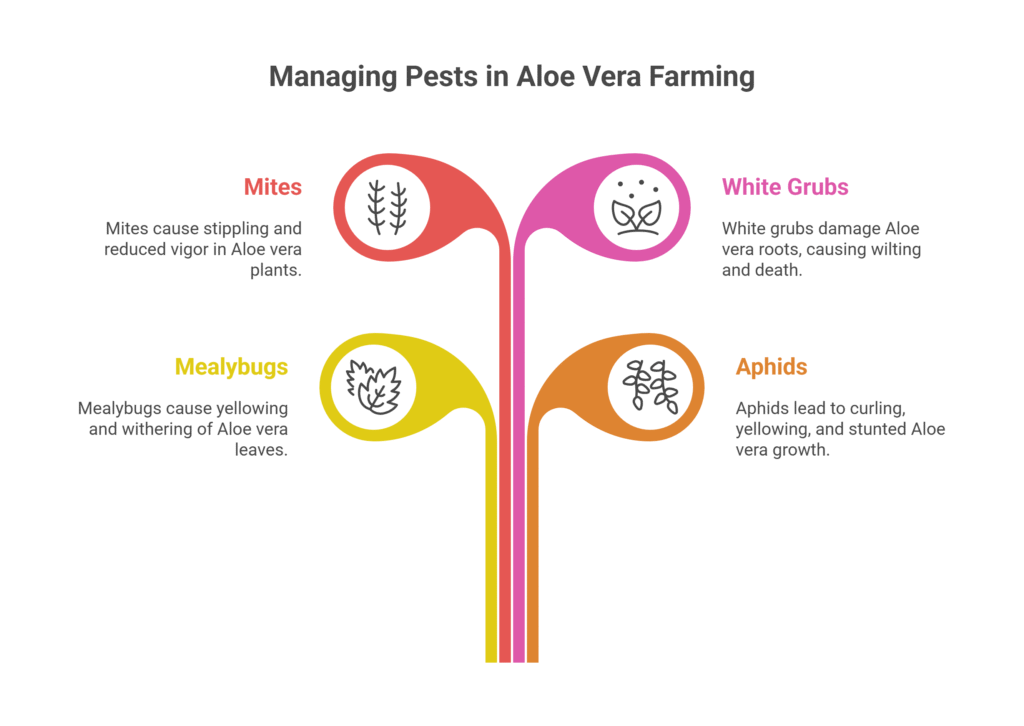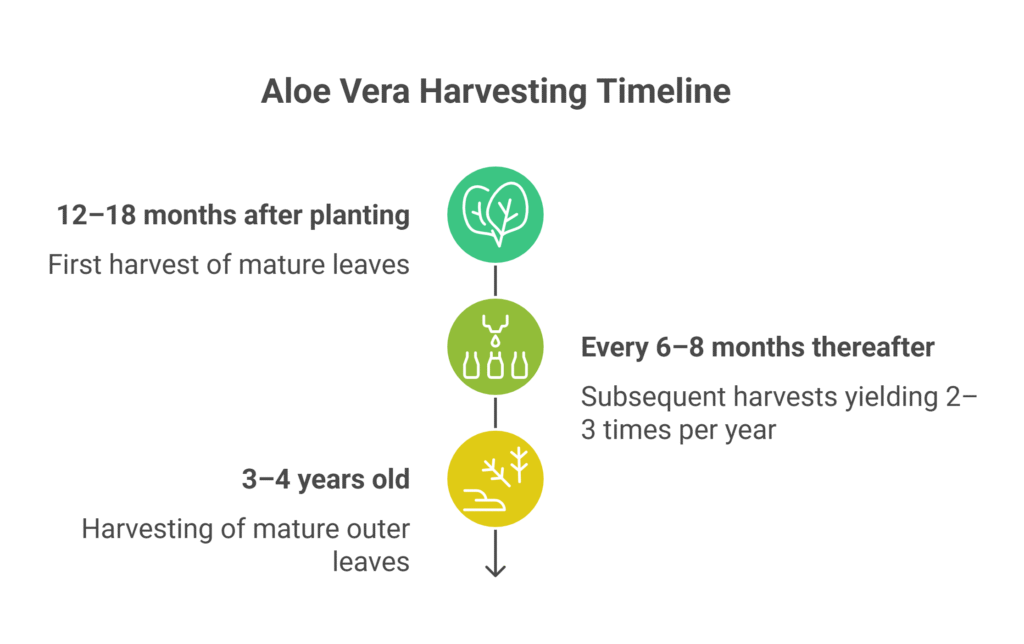Aloe Vera Farming
Aloe vera, a medicinal plant used in treatments for burns, sunburn, and skin conditions like eczema, pruritus, psoriasis, and acne, is characterized by its stemless growth, height of 24–39 cm, and thick fleshy leaves reaching 0.5 meters. For Aloe vera farming profit per acre, the break-even point is achieved in Year 3 (cumulative profit: NRs. 167,050), with peak returns in Years 3–4 generating NRs. 359,700 annual income and NRs. 284,700 yearly profits—contributing 57% of the total six-year profit.
However, yields decline by 35% in Year 5 and 50% in Year 6 versus peak years, reducing Year 6 profit by 79% compared to Year 3. Over six years, net profit reaches NRs. 672,685, delivering a 175% ROI on the initial NRs. 245,000 investments.

Land Preparation
The first stage in getting the field ready for aloe cultivation is to remove any weeds, rocks, garbage, and leftovers from past crops. In order to break up hard pans and enhance soil aeration and drainage, the field is then ploughed to a depth of 18 to 24 inches, preferably twice. To ensure proper water distribution and avoid waterlogging, the field is lastly leveled and harrowed to break up large soil clods into a fine tilth.
Planting on flat beds is an option, but in order to prevent root rot, it is highly recommended to create raised beds or ridges that are about 1-1.5 feet high and 3-4 feet wide with the proper furrows. This is especially important in places that are prone to severe rainfall or poor drainage.
Soil Type
Well-drained sandy loam to loamy soils are ideal for aloe vera growth, and proper drainage is crucial. Even on marginal grounds where other crops fail, it may grow on a variety of soil types, including rocky, sandy, and coastal soils, although it prefers slightly alkaline to neutral soils (pH 7.0–8.5).
However, to guarantee adequate drainage and plant health, extremely acidic, saline, or wet situations, as well as heavy clay soils, should be avoided completely or greatly enhanced with amendments like sand or organic matter.
Climatic Requirements
| Climatic Factor | Requirement / Preference | Notes |
| Temperature | Thrives: 25°C to 40°C (77°F to 104°F) Tolerates: Up to 48°C (118°F) if irrigated | Prefers warm, dry climates. |
| Frost Sensitivity | Highly sensitive. Damage: Below 5°C (41°F) Lethal: Prolonged below 0°C (32°F) | Not suitable for frost-prone areas without protection. |
| Light | Requires: Full sunlight (6-8 hours daily) | Tolerates partial shade, but growth and yield are reduced. Essential for optimal growth and gel production. |
| Rainfall | Prefers: Low to moderate (500-800 mm annually) | High humidity + rainfall increases disease risk. Supplemental irrigation is required in dry regions. |
| Wind | Strong winds can damage leaves. | Windbreaks may be necessary in exposed locations. |
Major Cultivars
| Cultivar Name | Key Characteristics |
| IC 111271 | Most widely cultivated; high-yielding, thick, fleshy leaves; high gel content |
| AL-1 | Popular variety, good yield, disease resistance |
| Sidhi | Perform well in specific regions (e.g., Madhya Pradesh) |
| Local Selections | High-performing types propagated by farmers; adapted to local microclimates |
| Barbadensis Miller | True Aloe vera; preferred for commercial gel production; thicker leaves; higher gel yield |
| Chinensis | Chinese Aloe; thinner leaves; less gel; not preferred for commercial production |
Propagation Material Rate per Acre
Aloe vera is commercially propagated vegetatively through suckers (pups or offsets) or rhizome cuttings (stem sections with buds), with around 15,000 to 20,000 suckers or cuttings required per acre based on the recommended spacing.
To ensure good establishment and yield, it is essential to use healthy, disease-free planting material obtained from certified sources or well-maintained mother plants. Before planting, the suckers should be dipped in a 0.1% Carbendazim solution for five minutes to protect against soil-borne diseases.
Planting
a) Planting Season
Aloe vera planting is best carried out during the monsoon season (June to August in many regions) to take advantage of natural rainfall for optimal establishment, though it can also be successfully planted in spring (February to March) if reliable irrigation is available. Planting should be avoided during peak summer heat and frost periods to prevent stress and poor survival.

b) Spacing
Common:60 cm x 45 cm
c) Pit Preparation
For Aloe vera cultivation, prepare pits measuring 30 cm x 30 cm x 30 cm at the designated spacing points. The excavated soil should be mixed thoroughly with 5–10 kg of well-decomposed farmyard manure or compost and a handful of neem cake or Single Super Phosphate (SSP) before refilling to enrich the planting medium and promote healthy root development.
d) Planting Method
In Aloe vera cultivation, planting is done by partially filling the prepared pits with the soil-manure mixture, then placing the sucker or rhizome cutting vertically in the center, ensuring its base is slightly below ground level. The soil is gently firm around the base to provide support, followed by light watering immediately after planting to aid establishment.
e) Number of Plants per Acre:
Based on the recommended spacing of 60 cm x 45 cm, approximately 14,988 Aloe vera plants can be accommodated per acre, ensuring optimal plant density for healthy growth and efficient land utilization.
Intercropping
Intercropping in Aloe vera fields is feasible during the first year, as the plant grows slowly initially, allowing the cultivation of short-duration, shallow-rooted, and low water- or nutrient-competing crops such as legumes (green gram, black gram, cowpea), vegetables (radish, onion), or medicinal plants like basil.
It is important to maintain at least 1 to 1.5 feet of space around Aloe plants to minimize competition for light and nutrients. Tall, dense, or heavy-feeding crops should be avoided, and intercropping offers the added benefit of generating supplementary income during the crop’s establishment phase.
Irrigation
| Aspect | Details |
| Principle | Drought-tolerant but requires irrigation for commercial yields. Use deep but infrequent watering, allowing soil to dry significantly between irrigations to prevent root rot. |
| Frequency | • Summer: Every 10–15 days • Winter: Every 20–25 days • Monsoon: Not required (unless a prolonged dry spell occurs) |
| Method | • Highly recommended: Drip irrigation (efficient, targeted delivery, avoids wetting leaves/crown) • Acceptable: Furrow irrigation (on well-drained ridges) • Avoid: Sprinklers |
| Watering Indicator | Apply water when the top 1–2 inches of soil are completely dry. |
| Signs of Water Stress | Wilting or thinning leaves. |
Fertilizer and Manure
Apply fertilizers according to the results of a soil test for best results; however, the following is a general recommendation for Aloe vera cultivation.
| Application | Fertilizer/Manure Type | Quantity per Acre | Application Method/Notes |
| Basal Dose (At Planting) | Well-decomposed FYM or Compost | 15-20 tonnes | Applied during land preparation. |
| Neem Cake | 250 kg | Improves soil health. | |
| Biofertilizers (Azotobacter, PSB) | 4-5 kg | Enhances soil health. | |
| Annual Dose | Nitrogen (N) | 40-50 kg | Split into 3 applications; best applied after harvests. |
| Phosphorus (as P₂O₅) | 60-80 kg | Applied as a basal dose. | |
| Potassium (as K₂O) | 40-60 kg | Applied as a basal dose. |
Weed Control
Weed control in Aloe vera cultivation is especially critical during the first 6–8 months after planting, as the plants are in their establishment phase. Regular manual weeding or shallow hoeing is the most common and effective mechanical method, taking care not to damage the roots.
Weeding should be done at proper intervals, typically twice a year, along with earthing up to keep the field clean. Mulching with organic materials like dried leaves, straw, or paddy husk, or using black plastic mulch around the plants, is highly recommended as it helps suppress weed growth, conserve soil moisture, and regulate soil temperature.
Flowering and Fruit Management
In Aloe vera cultivation, mature plants aged 2–3 years typically produce tall flower spikes with tubular yellow or orange flowers during winter or spring. However, flowering diverts energy from leaf and gel production.
To maximize vegetative growth and leaf yield, it is recommended to remove flower stalks as soon as they appear by cutting them close to the base. If seed production is required for breeding purposes, selected plants can be allowed to flower and set fruit, which forms as capsules containing seeds.
Pest and Disease Management
Common Pests
a) Mealybugs
Mealy bug infestation in Aloe vera, caused by pests such as Lepidocephalus and Pseudococcus, leads to yellowing and withering of leaves. To manage this, apply Methyl Parathion at 10 ml or Quinalphos at 20 ml per 10 liters of water, targeting both the roots and shoots of the plant for effective control.

b) Aphids
Aphids are sap-sucking insects that cluster on new growth and leaf undersides, causing curling, yellowing, stunted growth, and sticky honeydew that leads to sooty mold. Control them by spraying imidacloprid at 1 ml per liter of water, targeting affected areas during cooler times of the day. Repeat every 7–14 days as needed.
c) Mites
Mites in Aloe vera cause stippling or rust-like symptoms on the leaves, leading to reduced plant vigor, and can be effectively managed by applying miticides such as Dicofol.
d) White Grubs
White grubs, the larval stage of certain beetles, feed on the roots of Aloe vera plants, causing wilting, poor growth, and in severe cases, plant death. To manage this pest, apply neem cake to the soil, which acts as a natural deterrent and soil conditioner.
In cases of heavy infestation, drenching the soil with Chlorpyrifos solution provides effective control by targeting the larvae directly in the root zone. Regular monitoring and preventive soil treatments are essential for minimizing damage.
Common Diseases
a) Root Rot & Stem Rot
Among the most dangerous diseases affecting aloe vera are root rot and stem rot, which are brought on by pathogens such as Phytophthora, Pythium, and Fusarium and are usually brought on by waterlogging or inadequate drainage. Wilting, leaf yellowing, and a mushy or squishy base and root system are some of the symptoms.
Using disease-free planting material, avoiding overwatering, and making sure the soil drains well are all important aspects of prevention. It is advised to apply copper-based fungicides, Bordeaux mixture, or Trichoderma to the soil for management. To stop the illness from spreading, infected plants should be uprooted and destroyed very away.
b) Black, brown leaf spot (Alternaria, Colletotrichum)
Black brown leaf spots in Aloe vera are marked by the appearance of reddish-brown spores within oval or elongated pustules on the leaves. This fungal disease spreads rapidly under favorable conditions, especially when there is free moisture on the leaf surface and temperatures are around 20°C.
If such conditions persist, new generations of urediniospores can form every 10–14 days, leading to quick and widespread infection. Timely identification and management are essential to prevent severe damage.
c) Bacterial Soft Rot
Aloe vera suffers from bacterial soft rot, which quickly damages plant tissues and produces an unpleasant, watery decay. Plants that are infected should be taken out and destroyed very away. Avoid injuring plants and practice thorough field sanitation to prevent the disease.
d) Anthracnose
Aloe vera and other plants are susceptible to anthracnose, a fungal disease that causes a variety of symptoms, including dieback, twig cankers, dark leaf blotches, premature defoliation, and branch blight. These symptoms work together to impair plant health and lower output.
Warm, humid weather is ideal for the disease’s growth, and if treatment is delayed, it spreads quickly. Spraying a 70% neem oil solution works well to reduce anthracnose because it has potent antifungal qualities that help inhibit the infection, encourage tissue healing, and stop the disease from spreading. Effective disease management requires prompt application and routine monitoring.
Harvesting
The first Aloe vera harvest occurs 12–18 months after planting when the leaves are mature, thick, fleshy, and with tips slightly drying. Subsequent harvests take place every 6–8 months, typically yielding 2–3 harvests per year, with mature outer leaves (usually physiologically 3–4 years old) harvested first.

The harvesting method involves selecting the largest, healthiest outer leaves and cutting them close to the stem base (about 2–3 cm above) with a sharp, clean knife using a slanting cut to prevent water accumulation in the crown. Leaves should be handled carefully to avoid bruising and harvested during the cooler parts of the day, such as morning or evening. Mature plants usually yield 3–4 leaves per harvest.
Yield
An average leaf yield of 20-24 tonnes per acre per year can be expected from Aloe vera cultivation under typical growing conditions.
Cost of Investment per Acre for Aloe Vera Farming
| S.N. | Category | Cost (NRs.) |
| 1 | Land Preparation (plowing) | 20,000 |
| 2 | Plant suckers (as seed) | 15,000 |
| 3 | Ridge and Furrow making | 10,000 |
| 4 | Transplanting | 20,000 |
| 5 | Fertilizers and Manure | 35,000 |
| 6 | Irrigation (Drip) | 100,000 |
| 7 | Weed Control | 8,000 |
| 8 | Pest & Disease Control | 7,000 |
| 9 | Harvesting | 15,000 |
| 10 | Miscellaneous Costs | 10,000 |
| Total Initial Investment | 245,000 |
Annual Maintenance Cost per Acre for Aloe Vera Farming
The annual maintenance cost for Aloe vera cultivation from the second to the sixth year is estimated at NRs. 75,000 per acre. This cost includes expenses related to irrigation, weeding, pest and disease management, labor for harvesting, application of fertilizers and organic amendments, and general upkeep of the plantation.
Since Aloe vera is a perennial crop with relatively low input requirements after establishment, this annual cost supports ongoing productivity and ensures healthy plant growth for consistent leaf yields over multiple harvests.
Income from One Acre Aloe Vera Farming
| Year | Leaves/Plant | Avg. Leaf Wt (kg) | Yield/Plant (kg) | Total Yield/Acre (kg) | Price/kg (NRs.) | Income (NRs.) |
| 2 | 3 | 0.30 | 0.90 | 13,490 | 15 | 202,350 |
| 3 | 4 | 0.40 | 1.60 | 23,980 | 15 | 359,700 |
| 4 | 4 | 0.40 | 1.60 | 23,980 | 15 | 359,700 |
| 5 | 3 | 0.35 | 1.05 | 15,737 | 15 | 236,055 |
| 6 | 2 | 0.30 | 0.60 | 8,992 | 15 | 134,880 |
| Total | 86,179 | 1,292,685 |
Analysis of Aloe Vera Farming Profit Per Acre
| Year | Income (NRs.) | Total Costs (NRs.) | Annual Profit (NRs.) | Cumulative Profit (NRs.) |
| 1 | 0 | 245,000 | -245,000 | -245,000 |
| 2 | 202,350 | 75,000 | 127,350 | -117,650 |
| 3 | 359,700 | 75,000 | 284,700 | +167,050 |
| 4 | 359,700 | 75,000 | 284,700 | +451,750 |
| 5 | 236,055 | 75,000 | 161,055 | +612,805 |
| 6 | 134,880 | 75,000 | 59,880 | +672,685 |
The break-even point in Aloe vera cultivation is achieved in Year 3, when cumulative profit turns positive at NRs. 167,050. Years 3 and 4 are the peak earning periods, generating the highest annual income of NRs. 359,700 and a profit of NRs. 284,700 per year, contributing 57% of the total six-year profit.
However, returns begin to decline from Year 5, with yields dropping by 35% and by 50% in Year 6 compared to the peak years, resulting in a Year 6 profit that is 79% lower than in Year 3. Over the full six-year period, the net profit reaches NRs. 672,685, delivering a return on investment (ROI) of 175%, based on an initial investment of NRs. 245,000.
Crop Calendar for Aloe Vera Farming
(Based on tropical/subtropical climates; adjust for local rainfall patterns)
| Period | Activity | Key Tasks | Technical Specifications |
| Pre-Planting (Apr-May) | Land Preparation | • Clear weeds, rocks, debris. • Deep ploughing (18–24″) 2–3 times. • Harrow, level, form raised beds (1–1.5 ft high, 3–4 ft wide). | Soil: Sandy loam; pH 7.0–8.5. Avoid heavy clay/saline soils. |
| Planting (Jun-Aug) | Propagation & Planting | • Use suckers/rhizomes (15,000–20,000/acre). • Dip in 0.1% Carbendazim. • Plant in pits (30x30x30 cm) with FYM + neem cake. | Spacing: 60×45 cm (≈15,000 plants/acre). Season: Monsoon or spring (with irrigation). |
| Early Growth (Sep-Oct) | Initial Care | • Light irrigation (if dry spell). • Manual weeding + mulching. • Intercrop with legumes/vegetables (Year 1 only). | Intercropping: Basil, radish, onion. Maintain 1–1.5 ft space around Aloe. |
| Establishment (Nov-Mar) | Irrigation & Nutrition | • Winter: Irrigate every 20–25 days. • Apply 1st split of N (40–50 kg/acre). • Remove flower stalks. | Drip irrigation only. Avoid wetting leaves. |
| Peak Growth (Apr-Jun) | Summer Management | • Summer: Irrigate every 10–15 days. • Apply 2nd split of N. • Pest control (mealybugs, aphids). • Weed control + earthing up. | Pests: Spray imidacloprid (1ml/L) for aphids; Methyl Parathion for mealybugs. |
| Monsoon (Jul-Sep) | Disease Prevention | • Stop irrigation (unless dry spell >2 weeks). • Apply Trichoderma/copper fungicides. • Ensure drainage to prevent root rot. | Diseases: Root rot (Phytophthora), leaf spot (Alternaria). |
| Harvest (Oct-Mar) | Harvesting | • First harvest at 12–18 months. • Cut mature outer leaves (3–4/plant) with slanting cut. • Harvest 2–3 times/year. | Yield: 20–24 tonnes/acre/year from Year 3. |
| Annual Maintenance | Routine Care | • Apply full P₂O₅ (60–80 kg) + K₂O (40–60 kg) basal dose. • Reapply FYM (5–10 tonnes/acre). • Replant after 5–6 years. | Cost: NRs. 75,000/acre/year (Year 2 onward). |
Sources
National Medicinal Plants Board (NMPB), Ministry of AYUSH, India
ICAR-Directorate of Medicinal and Aromatic Plants Research (DMAPR), Anand, Gujarat
Central Institute of Medicinal and Aromatic Plants (CIMAP), Lucknow


